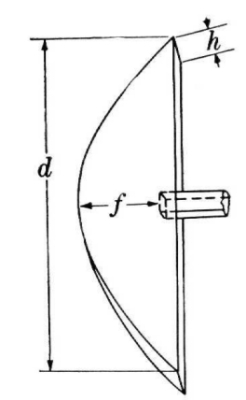PILLBOX ANTENNA DESIGN AND SIMULATION
A pillbox antenna is a linearly polarized cylindrical reflector embedded between two Parallel plates. It is usually fed by a waveguide. The pillbox is part of a family of antennas called fan beam antennas which produce a wide beam in one plane and a narrow beam in the other. The pillbox antenna can be dual polarized and is also a relatively wide bandwidth antenna.
 The advantages of using a pillbox antenna for radar applications are
The advantages of using a pillbox antenna for radar applications are- It is easy to design and the cost of production is low.
- It is dually-polarized and it is also a wide band antenna.
- It has a high power handling capability
The pillbox feed is traditionally located at the focal point of the reflector. For symmetrical antennas this is located in the middle of the aperture. Either a pin or waveguide feed can be used, depending on the system requirements. Further variations of these feeds can be found through the use of stubs which are used to obtain better impedance matching and reflector illumination, not discussed in this dissertation.
Pillbox Antenna with Waveguide Feed
Below is Pillbox antenna designed at 39 GHz. The feed is a waveguide feed. The  waveguide feed is first designed separately from the system. Flares are attached to the sides and optimized for the best reflection coefficient. Once the optimal configuration is obtained, the waveguide is used as a feed in the pillbox structure. Larger flares generally give a better reflection coefficient, but effectively increase the aperture of the waveguide, lowering the beam-width. The maximum gain of antenna is 25.6 dBi. Antenna polar plot (phi=90 degree) and E-field plot is shown below in figure.
waveguide feed is first designed separately from the system. Flares are attached to the sides and optimized for the best reflection coefficient. Once the optimal configuration is obtained, the waveguide is used as a feed in the pillbox structure. Larger flares generally give a better reflection coefficient, but effectively increase the aperture of the waveguide, lowering the beam-width. The maximum gain of antenna is 25.6 dBi. Antenna polar plot (phi=90 degree) and E-field plot is shown below in figure.
 waveguide feed is first designed separately from the system. Flares are attached to the sides and optimized for the best reflection coefficient. Once the optimal configuration is obtained, the waveguide is used as a feed in the pillbox structure. Larger flares generally give a better reflection coefficient, but effectively increase the aperture of the waveguide, lowering the beam-width. The maximum gain of antenna is 25.6 dBi. Antenna polar plot (phi=90 degree) and E-field plot is shown below in figure.
waveguide feed is first designed separately from the system. Flares are attached to the sides and optimized for the best reflection coefficient. Once the optimal configuration is obtained, the waveguide is used as a feed in the pillbox structure. Larger flares generally give a better reflection coefficient, but effectively increase the aperture of the waveguide, lowering the beam-width. The maximum gain of antenna is 25.6 dBi. Antenna polar plot (phi=90 degree) and E-field plot is shown below in figure.
The parabolic reflector reflects rays incident on its center directly back to the feed, this together with the narrow beam-width of the waveguide causes the majority of the energy to be reflected back into the waveguide, resulting in the impedance mismatch. One solution to this problem is to design the waveguide to have a wider beam-width and to radiate less energy in the centre through the use of stubs. Enlarging the pillbox width should also decrease the amount of energy reflected back into the feed.

Comments
Post a Comment